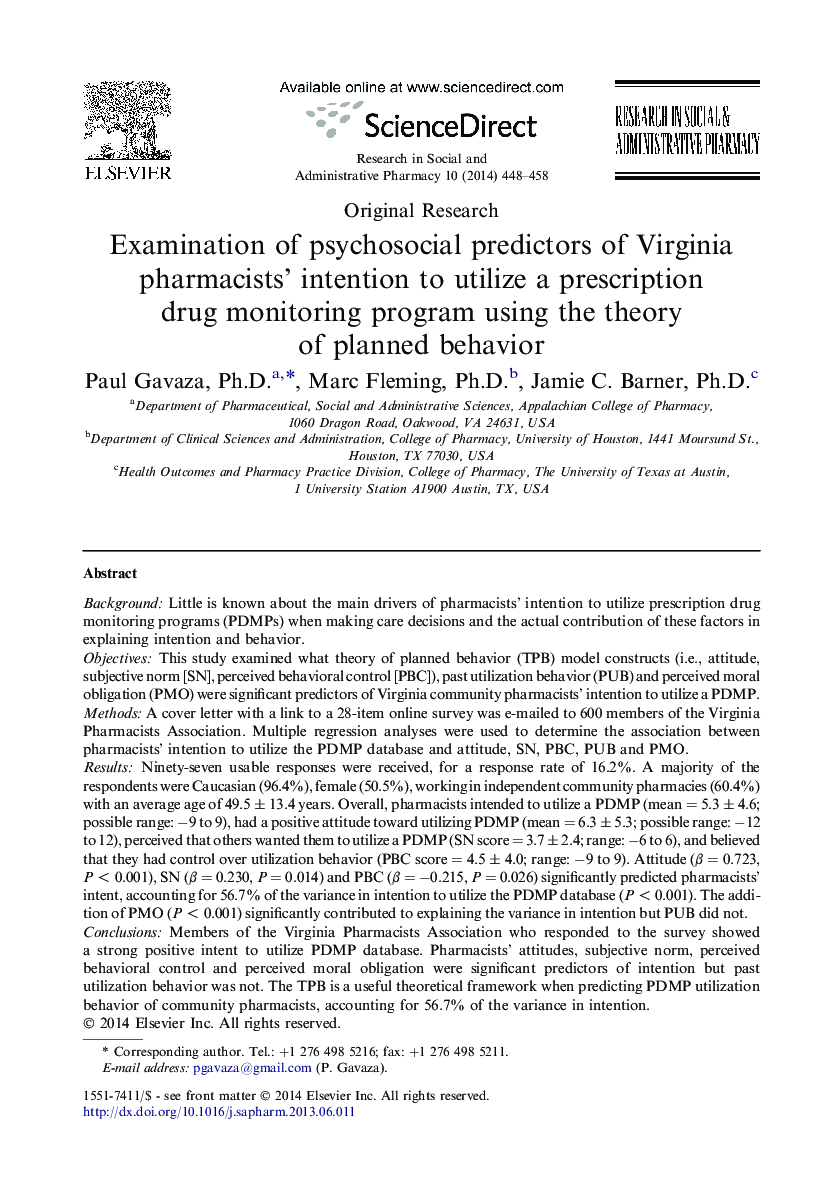| کد مقاله | کد نشریه | سال انتشار | مقاله انگلیسی | نسخه تمام متن |
|---|---|---|---|---|
| 2508581 | 1117612 | 2014 | 11 صفحه PDF | دانلود رایگان |
BackgroundLittle is known about the main drivers of pharmacists' intention to utilize prescription drug monitoring programs (PDMPs) when making care decisions and the actual contribution of these factors in explaining intention and behavior.ObjectivesThis study examined what theory of planned behavior (TPB) model constructs (i.e., attitude, subjective norm [SN], perceived behavioral control [PBC]), past utilization behavior (PUB) and perceived moral obligation (PMO) were significant predictors of Virginia community pharmacists' intention to utilize a PDMP.MethodsA cover letter with a link to a 28-item online survey was e-mailed to 600 members of the Virginia Pharmacists Association. Multiple regression analyses were used to determine the association between pharmacists' intention to utilize the PDMP database and attitude, SN, PBC, PUB and PMO.ResultsNinety-seven usable responses were received, for a response rate of 16.2%. A majority of the respondents were Caucasian (96.4%), female (50.5%), working in independent community pharmacies (60.4%) with an average age of 49.5 ± 13.4 years. Overall, pharmacists intended to utilize a PDMP (mean = 5.3 ± 4.6; possible range: −9 to 9), had a positive attitude toward utilizing PDMP (mean = 6.3 ± 5.3; possible range: −12 to 12), perceived that others wanted them to utilize a PDMP (SN score = 3.7 ± 2.4; range: −6 to 6), and believed that they had control over utilization behavior (PBC score = 4.5 ± 4.0; range: −9 to 9). Attitude (β = 0.723, P < 0.001), SN (β = 0.230, P = 0.014) and PBC (β = −0.215, P = 0.026) significantly predicted pharmacists' intent, accounting for 56.7% of the variance in intention to utilize the PDMP database (P < 0.001). The addition of PMO (P < 0.001) significantly contributed to explaining the variance in intention but PUB did not.ConclusionsMembers of the Virginia Pharmacists Association who responded to the survey showed a strong positive intent to utilize PDMP database. Pharmacists' attitudes, subjective norm, perceived behavioral control and perceived moral obligation were significant predictors of intention but past utilization behavior was not. The TPB is a useful theoretical framework when predicting PDMP utilization behavior of community pharmacists, accounting for 56.7% of the variance in intention.
Journal: Research in Social and Administrative Pharmacy - Volume 10, Issue 2, March–April 2014, Pages 448–458
